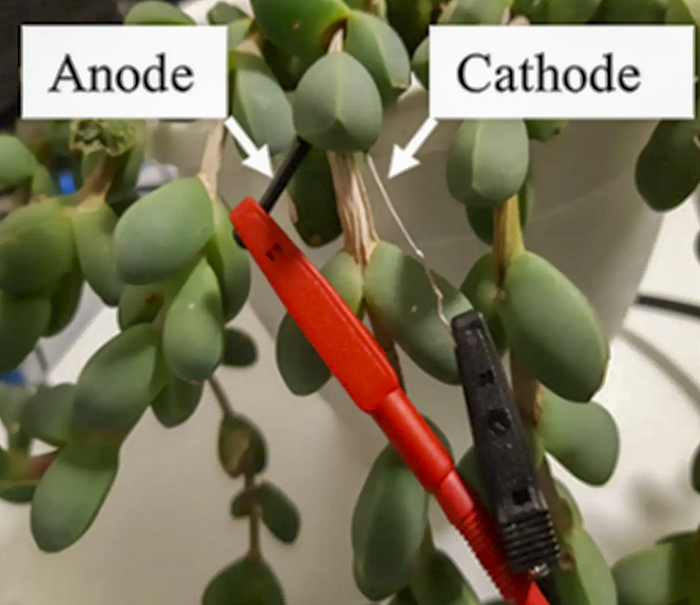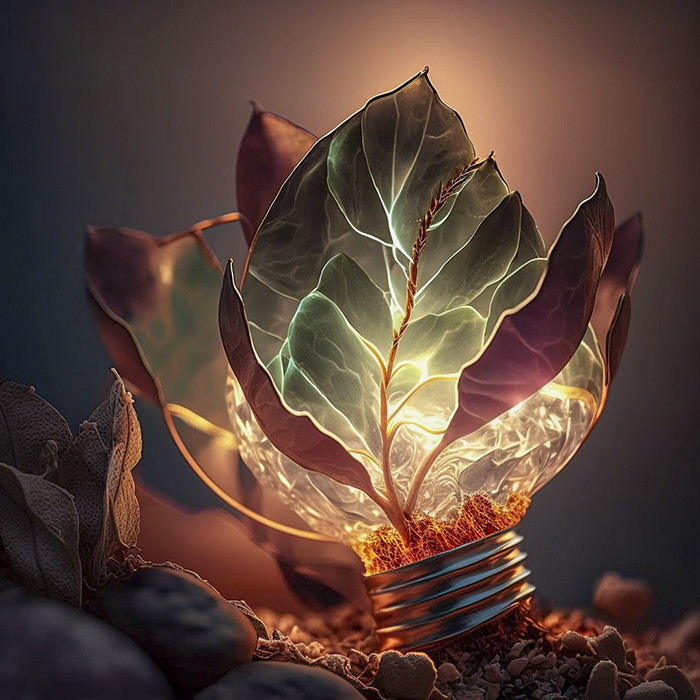
Dr. Yaniv Shlosberg, Prof. Gadi Schuster, and Prof. Noam Adir from the Technion – Israel Institute of Technology -- Make Clean Energy Possible by Creating a Living “Bio-Solar Cell” with Succulent Plants
For the first time, scientists were able to create an efficient living “Bio-Solar Cell” that runs on photosynthesis by using succulent plants (Corpuscularia lehmannii). According to Dr. Yaniv Shlosberg who developed the method during his Ph.D. in the Grand Technion Energy Program (GTEP), his team was able to harvest an electrical current directly from succulents turning each leaf into a small natural electrochemical cell by using the thick cuticle of the leaf as an envelope, and its inner water solution as a conductive electrolyte.
According to the article published recently in ACS Applied Materials & Interfaces, by inserting an iron anode and platinum cathode into a single Corpuscularia lehmannii leaf, a voltage of 0.28V was obtained. When connected to a circuit, up to 20 μA/cm2 bias-free photocurrent was produced per leaf. The succulent-based bio-electrochemical cell can produce direct electricity or Hydrogen gas. The stored gas can be used in a time of need in a Hydrogen fuel cell. Though the numbers were lower than a traditional solar cell, they are much higher than previous methods with other photosynthetic organisms which yield significantly lower electricity production. Dr. Shlosberg explains that although the obtained power output was significantly lower than applicative energy technologies that exist today in the market, it is just a proof of concept. The electricity production may be significantly enhanced by further development of the system to become a real cost-effective clean energy technology. The development of the system is nowadays conducted by Dr. Shlosberg together with Prof. Andrea Carlini, Nathan Nasseri, and Matthew Smith at the University of California Santa Barbara.
We are excited to be able to interview Dr. Yaniv Shlosberg to learn more about this research in detail and his future research interests.

Q: Congratulations on your recent creation of a living “bio-solar cell” that runs on photosynthesis, published in ACS Applied Materials & Interfaces. First of all, Please share with us your education and research background.
A: I did my B.Sc in medicinal Chemistry, at Bar-Ilan University, and my M.Sc in Analytical Chemistry in The Technion – Israel Institute of Technology developing methods for bacterial identification. My Ph.D. was in Bioelectrochemistry studying the harvesting of electricity from photosynthetic organisms. In my postdoctoral studies at the University of California Santa Barbara, I am developing new bio-electrochemical cells that are based on electron donation from different cells and organisms such as neurons, fruits, and sea animals. I am also a founder of a startup company that inspires to develop clean energy solutions based on live succulents and seaweeds.
Q: Please tell us about this “bio-solar cell” and how effective it is.
A: The bio-solar cell utilizes succulent leaves to produce electricity. A traditional non-biologic electrochemical cell consists of 2 electrodes, named Anode and Cathode, that are inserted into a conductive solution (Electrolyte), while the electron source may originate from the decomposition of a metallic anode or added molecules that can donate electrons at the anode. The system must be enclosed to prevent the escape of the electrolyte. In our bio-photo electrochemical cell (BPEC), the thick cuticle of the succulent leaf is the envelope while the inner conductive solution applies as a good conductive electrolyte. An anode and Cathode are inserted into the leaf. Upon sunlight illumination, photosynthesis occurs inside the leaf producing a molecule named NADPH. This molecule applies as an electron source that can donate electrons at the anode to produce electricity. The inner solution of the leaf also consists of other electron donors which can also produce electricity in the dark that is lower than in light.
Q: How is it different from previous methods to generate electricity that runs on photosynthesis?
A: Previous works based on photosynthesis mostly used unicellular organisms such as cyanobacteria or microalgae. In this case, the organisms are microscopic and typical electrodes that are about 10,000 times bigger than the organisms cannot be inserted. In these systems, the NADPH or other molecules that are capable of donating electrons have to cross many barriers that exist in the cells, making the electricity production significantly lower.
Other methods isolate the pure photosynthetic components from the plant leaves trying to concentrate the net active material. However, the isolation process may be very expensive and the produced electrical current is relatively low and inadequate for applicative technologies. The method which produces the maximal electricity utilizes seaweeds and kelp which is about 10 times bigger than succulents. However, the ability to cultivate them is limited by regulations and much more complex than growing succulents that can be easily done on a large scale without much effort.
Q: Why is water in plants important in terms of converting light energy to chemical energy?
A: The water solution in the plant applies as the natural electrolyte of the bioelectrochemical cell (that is an essential component in an electrochemical cell). It is conductive and consists of molecules that can donate electrons at the anode applied as the energy source.
Q: Please tell us what makes the succulent, Corpuscularia lehmannii, special? Are there other plants carrying similar characteristics that could also be used in your research?
A: Corpuscularia lehmannii is among the popular succulents that are being grown in nurseries for decoration. It can grow in harsh environmental conditions and has small leaves. This may be an advantage as each leaf may apply as a bio-electrochemical cell while the leaves may be wired to each other to significantly increase the power output. Nevertheless, the ability to produce bio-electricity is not specific to this plant. Probably, almost any succulent can be used. In my present research together with my associate researchers – Prof. Andrea Carlini, Nathan Nasseri, and Matthew Smith – we are now studying the ability of a large variety of succulents to produce electricity, trying to determine which is the best species to use.
Q: What kind of future applications do you envision that could use your technology? For example, living in space?
A: Me and my colleagues, Prof. Noam Adir and Prof. Gadi Schuster, have discussed many times the possibility of bioelectricity in space. Succulents and other plants may produce electricity, and oxygen and be a source of food. I heard of the successful works of scientists to grow plants in space, which makes me think that our idea is possible. However, this is a long-term plan. Our primary goal is to develop clean energy technologies on earth to help in the struggle against global climate change and replace contaminating fossil fuels. Fossil fuels are defined as “positive carbon”, which means they emit carbon dioxide into the atmosphere in a combustion process. The world is now aspiring to “Zero carbon” technologies that do not involve any carbon emission, such as hydrogen fuel cells. In the case of photosynthetic bio-electrochemical cells, we create a new class, “Negative carbon”! Instead of emitting carbon dioxide, our method reduces its quantities in the atmosphere by consuming it for photosynthesis. We envision two kinds of systems: 1. local succulents that will be used to operate or charge low-energy devices such as LEDs, cameras, laptops, or cell phones. 2. Big fields of succulents that will produce high quantities of electricity.
Q: What other areas of research also interest you?
A: I was always attracted to scientific fields that inspire to struggle against major critical problems of mankind. Rather than clean energy science, which is nowadays very important because of climate change, I am interested in the development of biomedical devices.
Following the recent pandemic all over the world and the fear of the tolerance of pathogenic bacteria to antibiotics, I started to be interested in plastic antibodies. These are a new class of polymeric components that may be used in the future for the diagnosis and targeting of viruses and bacteria.
I am also very enthusiastic about 3D printing and bio-printing which I predict to be the next technological revolution in the near future.
Q: Is there anything else you would like to tell our readers?
A: I am optimistic about the struggle against climate change. There is a great global effort to invent new green energy technologies; I believe the combination of many novel technologies will be able to solve the problems and prevent future disasters.
*****
We hope Dr. Yaniv Shlosberg’s insightful words will inspire more people to look for clean energy solutions and other exciting scientific research helping humans to solve difficult problems.
